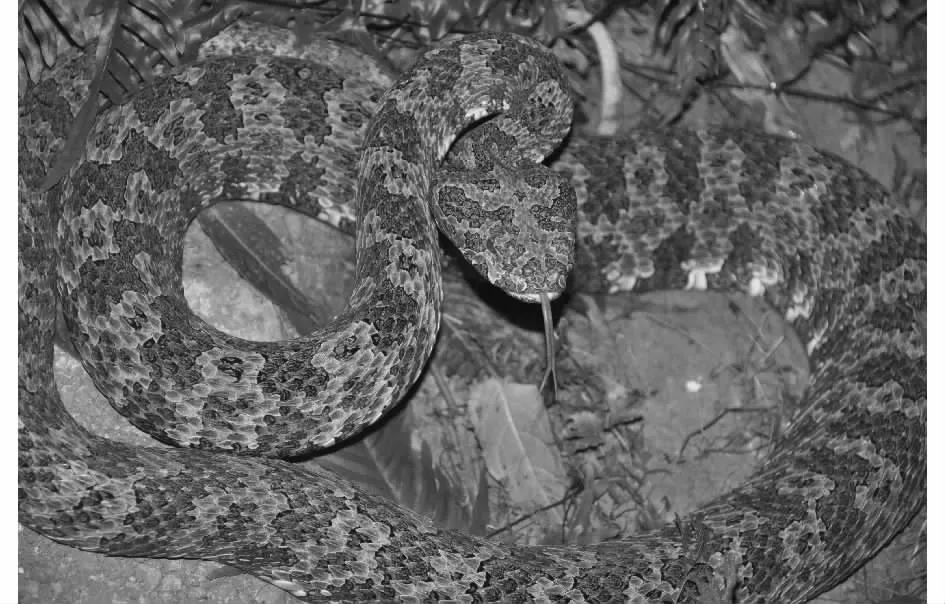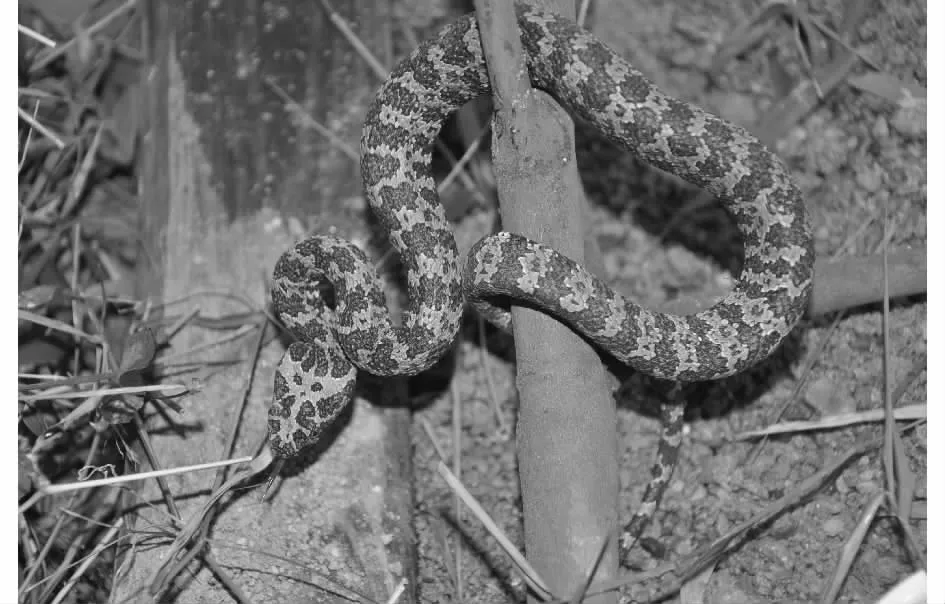The Survey of Ermia mangshanensis Resource in South China Tiger Nature Reserve
Heping XIE,Shizhou LI,Jianrong WANG,Yuanhui CHEN,Lianchao CHEN,Shengqiao LEI
Management Office of South China Tiger Nature Reserve in North Guangdong,Shaoguan 512023,China
Ermiamang shanensis,as a snake species unique to China,was first discovered in Hunan Mangshan National Nature Reserve in 1989,and was officially named by academia in 1990.The distribution area of this species is narrow,and it has precious value,resulting in serious human poaching and capturing.The endangered situation has exceeded that of python listed as Class INational Key Protected Species in 1988[1],and it is known as the"panda"in snakes.But so far,this species has not been effectively protected.During the period 2010-2012,the researchers in South China Tiger Nature Reserve in North Guangdong and Hunan Mangshan National Nature Reserve conducted field survey of Ermia mangshanensis in the Shapingpian area at the junction of South China Tiger Nature Reserve in North Guangdong and Hunan Mangshan National Nature Reserve,in order to provide the basis for better protecting this species.
1 Natural overview
South China Tiger Nature Reserve in North Guangdong(112°58′22″-113°02′11″E,24°56′40″-25°03′11″N),with a total area of16360.8 hm2,is adjacent to Guangdong Nanling National Nature Reserve and Hunan Mangshan National Nature Reserve,and Hunan Rongjiadong Provincial Nature Reserve.The terrain is complex in the Shapingpian area of the nature reserve,and the relative elevation difference can reach 1522 m(the highest elevation of1902m and the lowest elevation of380 m).
Due to the location in the south of the Nanling Mountains,the Nanling Mountains become a natural barrier to airflow and weather systems,and after the cold air crosses over themountain,the sinking will increase the temperature,so that the temperature will not fall sharply,correspondingly reducing the frost caused by cold air flow.The annual average temperature is 17.2℃;the frost-free period is290 d;the annual rainfall is1600-2775mm;the annual relative humidity is 82.8%;the vegetation coverage rate is97%.
2 Planning and design
According to the operation methods stipulated by the State Forestry Administration's Technical Regulations for National Terrestrial Wildlife Resources Survey and Monitoring,this survey uses the appropriate planning and design methods.In accordance with the terrain features at the junction of South China Tiger Nature Reserve in North Guangdong and Hunan Mangshan National Nature Reserve,this survey also uses the"day spacing planning method"and"night route design method",to design the survey route,plot and survey area.The"day spacing planning method"means that during 10:00-16:00,according to the length of habitat,region and planning route,the belt transect method is used and it is required that the average exploration distance ateach side should not be less than 15m[1];the number of surveyors is 4,divided into 2 groups,and the spacing is 20-50 m;the same route is followed to carry out the search-type survey in batches.
The"night route design method"is to choose the woodland habitats with excellent resources,for the field survey at 19:00-22:00 according to the night route design.
The plot planning method is to randomly select the 50m×30m or 30m×30m plot in the key areas according to the woodland habitats and terrain,for exploratory search,and it is required to design two ormore plots in each route.
The survey covers the entire Shapingpian area(16.24 hm2),and the survey route is up to 1000 km.
3 Results and analysis
3.1 The number and distributionDuring the survey,we found 3 living Ermiamangshanensis,picked up 7 snake eggs and successfully hatched 3 young snakes(Fig.1,2).Through the interviews with the local people and secret inquiries with the phone,we collected 8 valid messages.This survey conducted calculation based on the population density of 3 to 5/km2[1].
In the Shapingpian area of South China Tiger Nature Reserve in North Guangdong,there are about48 to 80 Ermiamangshanensis,and the population is very rare,in extreme endangered state.Themain reasons are excessive human influence over the habitats of this species[2],human poaching,the destruction of natural habitats,and reduced living area[3].

Fig.1 Adult Ermiamangshanensis

Fig.2 Young Ermiamang shanensis
3.2 The strong zonal selectivity for this populationThis specieswas originally described in the genus Trimeresurus[4].Ermiamang shanensis isa venomous pitviper species endemic to Hunan and Guang dong provinces in China.It is reputed to be one of two species(alongside the rinkhals)other than cobras known to spit venom.
No subspecies are currently recognized.It is found only in the zones with the altitude of800-1200m.The main reasons for its zonal selectivity including the following factors:
3.2.1 The population having strong dependence on the unaffected habitats in the Shapingpian area of South China Tiger Nature Reserve.It is found from the survey that in addition to Mangshan National Nature Reserve,Ermiamangshanensis is also distributed in the primitive natural forests that have not been affected by mankind in the core area of South China Tiger Nature Reserve at present.The forests in the core area of the nature reserve have not yet been felled and woodlands have not been affected by human mining,so now it also becomes the unique habitat in Guang dong for Ermiamang shanensis.
In the places where the treesare felled and woodland is artificially exploited,Ermia mangshanensis never appears due to frequent human activities such as water and electricity resource development and mining of mineral resources.The secondary natural forest vegetation iswell restored in the Shapingpian area of South China Tiger Nature Reserve,and the primitive forests are well preserved.
In recent years,this species is also found in Babao sawmill and surrounding places.The forest areas inhabited by this snake,like isolated islands,are distributed in the well-preserved narrow virgin forest area in Shapingpian of South China Tiger Nature Reserve,indicating that the protection of natural forests and habitat is of great significance to the rise and fall of Ermiamangshanensis population[5].
3.2.2 The distribution of population having strong dependence on zonal selectivity.Ermia mangshanensis is currently only distributed in some forest areas of Shapingpian in South China Tiger Nature Reserve in North Guangdong and the surrounding areas as well as the narrow scope of Hunan Mangshan National Nature Reserve and Rongjiadong forest farm,with small living area and low population density.
3.2.3 The population existence showing the feature of zonal distribution.In the Shapingpian area of South China Tiger Nature Reserve in North Guangdong,Ermiamangshanensis is found only in the zone at an altitude of800-1200m,and it is most frequently found in the zone at an altitude of800-1100m,indicating that the climate in this zone is very suitable for the survival of Ermia mangshanensis.
If the altitude is high,the temperature will be low;if the altitude is low,the temperature will be high[1].It is also related to the excessive human impact on the forest.
4 Recommendations
4.1 Strengthening the policy protectionErmiamangshanensis is still listed as the protected useful wild animal of important economic and scientific research value in the current Wildlife Protection Act,and due to the low level of protection,law-executors can not measure punishment on the illegal capture and trafficking behavior or the punishment is too light,with no warning effect.
In order to effectively protect this species resource,it is necessary to strengthen the protection from the policy[6].Using the policies to protect the Ermia mangshanensis population is one of the most important tasks at present[7].
It is necessary to upgrade this species to the national key protected wild animal from the laws and policies,include the protection and management of Ermiamangshanensis resource in national unifiedmanagement,include the protection of species resource in the national plans,and strictly control hunting.Without the approval,any unit or individual is prohibited from private hunting,gathering,acquisition and export.
4.2 Laying great emphasis on the publicity,education and popular science work for resource protectionThe publicity,education and popular science work for the natural resource protection is an important part of the protection cause of nature reserves,and one of the important indicators for assessing the effective management of protected areas,therefore,the protected areas should take advantage of the publicity and popular science education activities to make the whole society attach great importance to the protecting work of natural resources in the nature reserves,and make the major decision-makers and the masses fully realize the strategic importance of natural resource conservation.
Using the newspapers,radio,television,movies,pictures and other publicity channels,it is necessary to carry out the extensive and lively publicity,and actively carry out some social activities such as Environmental Protection Day,Tree Planting Day and Bird-Loving Week,to enhance people's awareness of ecological protection.
It is necessary to praise the units or individuals making significant achievements in the protection of natural resources,and criticize any behavior of destructing the natural resources and causing serious consequences;develop systems to encourage and protect the individuals reporting the poaching behavior.
Furthermore,it is necessary to vigorously popularize scientific and cultural knowledge,particularly the scientific knowledge on species and ecological balance.The whole staff in the protected areas should set a good example and perform duties honestly,take the lead in improving the ideology of love for the natural resources,and mobilize local residents to actively participate in the protection of natural resources.
4.3 Combining the artificial breeding and reintroduction to enhance the population intensityErmiamangshanensis is a unique species in Hunan Mangshan National Nature Reserve,but the studies of the protection and breeding of the species still stay on the surface,and they are not emphasized continuously.With the annual ceaseless poaching,Ermia mangshanensis has become an endangered species,and the wild breeding situation can notbe determined.
In order to effectively complement and enhance the quantity of wild population and protect this species,there is a need to promote in-depth study of artificial breeding.The establishment of breeding research base and artificial breeding is of great significance to restoring wild populations[8].At the same time,it is necessary to effectively supplement the wild population of this species by reintroduction.
[1]CHEN YH.Survey report of Trimeresurusmangshanensis sources[J].Journal of Snake,2003,15(1):62-63.(in Chinese).
[2]ZHAOEM,CHENYH.Description of anew species of the genus Trimeresurus[J].Sichuan Journal of Zoology,1990(1):11.(in Chinese).
[3]CHEN YH.The current status of Ermiamangshanensis and conservation strategy[J].Sichuan Journal of Zoology,1998,17(2):76.(in Chinese).
[4]WANG S.Resources of snakes in Huangfu Mountain Natural Preservation fields,Anhui Province[J].Journal of Anhui Agrotechnical Teachers College,1998,12(2):46-48.(in Chinese).
[5]QUWY,LU JQ,LIJJ,et al.Herpetodiversity in Henan Province and conservation[J].Sichuan Journal of Zoology,1998,17(2):81-82,85.(in Chinese).
[6]ZHOU ZY,LIPP,LU YY,et al.The Chinese endemic snake resourcesand proposals to protection[J].Sichuan Journal of Zoology,2008,27(1):44-47.(in Chinese).
[7]XIE HP,ZOUWJ,WANG JR.Apply of digital monitor system in domesticating and breeding research of South China Tiger[J].Guangdong Forestry Science and Technology,2012,28(1):30-34.(in Chinese).
[8]LISZ.Study on breeding technology of South China Tiger under the seminatural condition[J].Guangdong Forestry Science and Technology,2012,28(4):44-44.(in Chinese).
 Asian Agricultural Research2014年7期
Asian Agricultural Research2014年7期
- Asian Agricultural Research的其它文章
- Quantile Regression Analysis on Convergence of China's Regional Econom ic Grow th
- A Study on Antibacterial Activity and Chem ical Com position of the Petroleum Ether Extract from Aspergillu sniger Mycelia
- Current Situation of Information Demand of Farmers in Taihang Mountain Area:A Case Study of Pingshan County in Hebei Province
- Analysis of the Influencing Factors and Key Driving Force concerning the Efficiency of Green Supply Chain of Fruits and Vegetables
- Study of the Option Ordering Policy concerning Perishable Farm Produce Based on Revenue Sharing Contract
- Study on Rural Poverty Reduction Effect of Traffic Infrastructure
